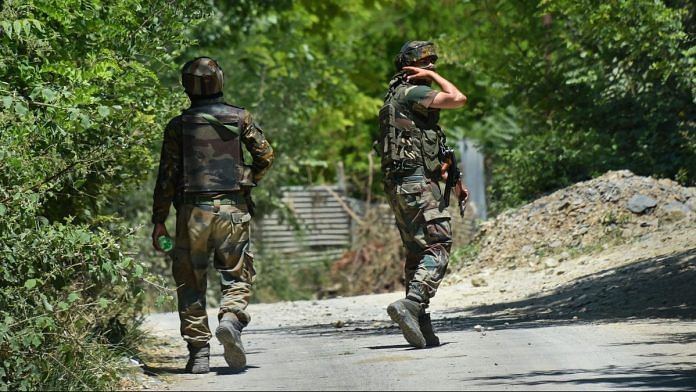Thank you dear subscribers, we are overwhelmed with your response.
Your Turn is a unique section from ThePrint featuring points of view from its subscribers. If you are a subscriber, have a point of view, please send it to us. If not, do subscribe here: https://theprint.in/subscribe/
In the heart of South Kashmir, where orchards once promised livelihoods, a generation of boys was stolen by a ruthless trade in violence. At the centre of this devastation stands Arjumand Gulzar, alias Hamza Burhan, a self-styled Al-Badr commander. He was not a martyr but a manipulator who trafficked in human lives. He now resides in Pakistan-occupied Kashmir (PoK), still orchestrating networks preying on youth.
Born in Kharbatpora, Ratnipora (Pulwama), Arjumand left for Pakistan in 2017 under the pretext of pursuing higher studies. That journey laid the foundation for his involvement in organised militancy. By 2018, his name surfaced in videos where he issued open threats to police and civilians. He styled himself as a radicaliser, peddling the illusion of “honour through violence” to impressionable teenagers. Families across Pulwama later recounted how young men who encountered him gradually slipped into militancy. To elevate his image, he even took credit for operations carried out by others.
From Pulwama to Shopian, his network expanded rapidly. Partnering with Yousuf Baloch, a veteran arms conduit, Hamza ran a twofold enterprise: recruitment and supply. While he radicalised and indoctrinated, Baloch facilitated weapons and funds. The results were devastating. Every month, new recruits emerged—each younger and more expendable. Within weeks, many were dead. Behind the façade of ideology lay pure commerce. Hamza was not fighting for a cause; he was managing a business of blood.
The Lawaypora encounter In Srinagar exposed the depth of his cruelty. Three young men, including Athar Mushtaq, were killed in circumstances that remain disputed. Evidence later suggested that Hamza had trapped them into carrying weapons, then leaked their details for monetary gain. Recruit, exploit, discard—this was his pattern. Each loss became another line in his ledger.
By 2020, even Al-Badr grew uneasy with his profiteering and misinformation. The group eventually distanced itself from him in 2021. But Hamza, ever adaptable, rebranded under a new name: the Lone Wolf Warriors (LWF). This outfit orchestrated targeted killings of non-locals, selective attacks on pro-India voices, and sporadic strikes designed to maintain fear and relevance. His strategy was simple—create chaos, claim responsibility, and remain indispensable to handlers across the border.
As South Kashmir bled, Hamza thrived across the Line of Control. Today, he enjoys wealth and safety in Muzaffarabad, where he reportedly serves as President of Media Front RS TV and holds a 50% stake in AIMS Higher Secondary School, Gojra, Muzaffarabad. Married and well-settled, he continues to coordinate recruitment remotely through encrypted platforms. While Kashmiri families mourn their sons, he lives amid comfort and privilege—his fortune built on the graves of teenagers who trusted his deceit.
His story exposes a darker reality—how terrorism in Kashmir evolved from ideological rebellion into an industrialised enterprise. Men like Hamza Burhan operate as middlemen between handlers abroad and foot soldiers on the ground. They manipulate emotional grievances, manufacture narratives of martyrdom, and monetise militancy. For them, conflict is currency, and young lives are expendable assets.
This model thrives on despair: families lose sons, communities lose a future, while self-styled “commanders” accumulate wealth and protection. Their rhetoric of resistance conceals the economics of exploitation. Each recruit becomes both a propaganda tool and a revenue source. This pattern underscores the urgent need for coordinated efforts among local governance, law enforcement and intelligence agencies to dismantle these ecosystems.
The victims of this trade still await justice. Mothers whisper their sons’ names into the dark; fathers tend graves instead of planning weddings. The real battle in Kashmir is not ideological—it is moral. It is the struggle to protect young minds from predators who weaponise identity and sell violence as virtue.
Kashmir’s youth must be shown that dignity lies in education, not extremism; in progress, not propaganda. Civil society, media, and diplomatic institutions must collaborate to amplify voices of victims, expose the profiteers, and counter the narrative that glorifies militancy. De-radicalisation efforts must move beyond policing to prevention—offering mentorship, employment, and platforms for dialogue.
Today, Arjumand Gulzar remains alive in PoK—still plotting, hungry for recruits. That fact must strengthen the resolve of both state and society. His existence is a reminder that silence empowers manipulators and indifference sustains their trade. South Kashmir must rise above fear and reclaim its sons from the machinery of death that has consumed its youth for far too long.
If there is to be healing, it begins with truth. The story of Hamza Burhan is not just about betrayal; it is about awakening—a call for Kashmir to see through the illusions sold in the name of freedom. Only when the business of blood is dismantled can the Valley breathe again, and justice return to its soil.
By Murtaza Ali
Counter-Terrorism & Counter-Intelligence Analyst
These pieces are being published as they have been received – they have not been edited/fact-checked by ThePrint.


